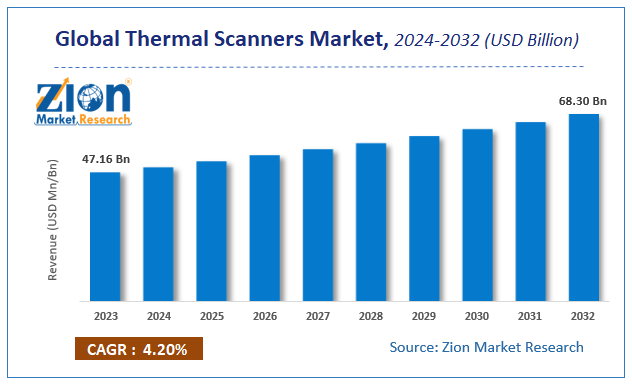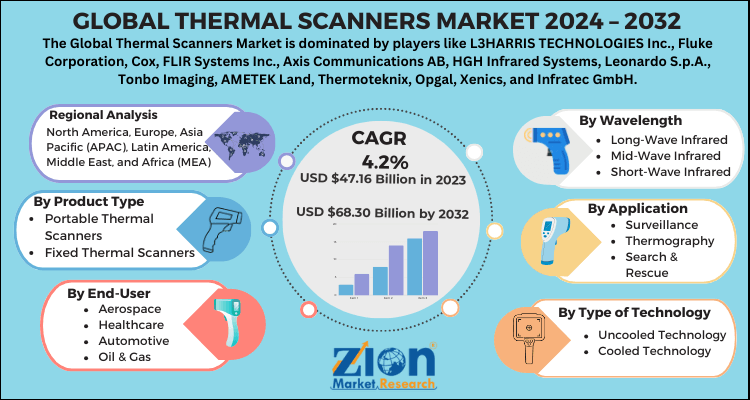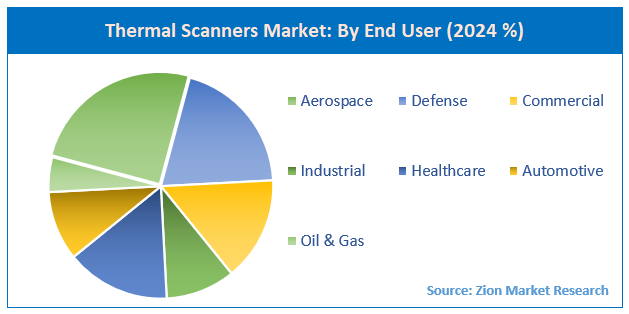Thermal Scanners Market Size, Share, Trends and Forecast, 2032

Thermal Scanners Market By Product Type (Portable Thermal Scanners and Fixed Thermal Scanners), By Type of Technology (Uncooled Technology and Cooled Technology), By Wavelength (Long-Wave Infrared, Mid-Wave Infrared, and Short-Wave Infrared), By Application (Surveillance, Thermography, and Search & Rescue), By End-User (Aerospace, Defense, Commercial, Industrial, Healthcare, Automotive, and Oil & Gas), and By Region: Global Industry Analysis, Size, Share, Growth, Trends, and Forecast, 2024 - 2032
| Market Size in 2023 | Market Forecast in 2032 | CAGR (in %) | Base Year |
|---|---|---|---|
| USD 47.16 Billion | USD 68.30 Billion | 4.2% | 2023 |
Description
Thermal Scanners Market Insights
According to the report published by Zion Market Research, the global Thermal Scanners Market size was valued at USD 47.16 Billion in 2023 and is predicted to reach USD 68.30 Billion by the end of 2032. The market is expected to grow with a CAGR of 4.2% during the forecast period. The report analyzes the global Thermal Scanners Market's growth drivers, restraints, and impact on demand during the forecast period. It will also help navigate and explore the rising opportunities in the Thermal Scanners industry.
Key Insights
- As per the analysis shared by our research analyst, the thermal scanners market is anticipated to grow at a CAGR of 4.2% during the forecast period (2024-2032).
- The global thermal scanners market was estimated to be worth approximately USD 47.16 billion in 2023 and is projected to reach a value of USD 68.30 billion by 2032.
- The growth of the thermal scanners market is being driven by the growing need for non-contact temperature measurement and monitoring across healthcare, industrial, and security applications.
- Based on the product type, the portable thermal scanners segment is growing at a high rate and is projected to dominate the market.
- On the basis of type of technology, the uncooled technology segment is projected to swipe the largest market share.
- In terms of wavelength, the long-wave infrared segment is expected to dominate the market.
- Based on the application, the surveillance segment is expected to dominate the market.
- In terms of end-user, the aerospace segment is expected to dominate the market.
- By region, North America is expected to dominate the global market during the forecast period.
Thermal Scanners Market: Overview
A thermal scanner refers to a contactless infrared device that can assess surface skin temperature to determine if an individual has a high temperature much faster than a traditional thermometer. The thermal scanner is designed to capture an image of the object via the infrared radiation emitted from it. The image that is created reveals the temperature of the object. In the present times of the Covid-19 pandemic, in order to mitigate the issue of shortage of thermometers, the utilization of thermal scanners is being promoted by the governments of numerous countries worldwide.
Thermal Scanners Market: Growth Factors
The global market for thermal scanners is receiving significant impetus from the pandemic-induced mass screening at public places such as airports. Traditional thermometers cannot be used for the purpose of screening for a high temperature, as these are not as accurate and quick as thermal scanners. Moreover, thermal scanners are contactless solutions, adhering to social distancing and hygiene practices. Another key factor aiding the growth of the market is the increasing amount of R&D investments worldwide. The high rate of technological progress is also supporting the growth of the global thermal scanners market. The high degree of demand for thermal scanners from the automotive sector is also expected to accelerate expansion over the forthcoming years.
Apart from this, the global thermal scanners market is also being propelled by a high degree of deployment for security and surveillance purposes. The security and surveillance segment is likely to display remarkable growth, owing to the need for solutions such as CCTV cameras for a plethora of purposes. Thermal scanners are also widely adopted for law enforcement, border surveillance, and collision avoidance in the defense sector, further boosting market expansion.
Thermal Scanners Market: Segmentation
The global thermal scanners market can be segmented on the basis of type of product, type of technology, wavelength, application, end-user, and region.
On the basis of Product Type, the thermal scanners market can be segmented into portable thermal scanners and fixed thermal scanners. In the past few years, the fixed thermal scanners segment dominated the market for thermal scanners and might continue to do so over the next few years. The high rate of adoption of these devices can be attributed to their versatility, accuracy, and reliability. Not only can they be utilized across numerous applications such as steel and ceramics, but also require minimum human interference.
Uncooled technology and cooled technology are the two prominent segments in terms of type of technology.
On the basis of the wavelength involved, the market for thermal scanners can be segmented into long-wave infrared, mid-wave infrared, and short-wave infrared. The long-wave thermal scanners segment emerged as the leader, but the mid-wave segment is expected to achieve the foremost position over the forecast period too. Surveillance, thermography, and search & rescue are some key market segments based on application. The thermal scanners market can be segmented into aerospace, defense, commercial, industrial, healthcare, automotive, and oil & gas verticals based on end-user.
Recent Development
- In May 2021, Teledyne Technologies completed its $8 billion acquisition of FLIR Systems, integrating FLIR’s thermal imaging capabilities into the newly formed Teledyne FLIR LLC to strengthen its position in advanced sensing solutions.
- In January 2025, Excelitas Technologies acquired Heraeus Noblelight, expanding its global footprint in infrared sensing and thermal imaging technologies across industrial, medical, and scientific applications.
- In January 2025, Exail acquired Leukos, a Swiss firm specializing in advanced laser sources for metrology, spectroscopy, and imaging. The acquisition reinforced Exail’s expertise in photonics and precision instrumentation.
- In February 2025, 4JET Technologies acquired Corning Laser Technologies, enhancing its capabilities in laser-based glass processing and thermal imaging—particularly for industrial and display applications.
- In 2025, Ophir Optronics introduced a high-resolution thermal camera tailored for industrial inspection. The device offers improved accuracy for predictive maintenance and quality control in manufacturing environments.
- In 2025, Leonardo secured a contract to supply thermal cameras for smart city surveillance projects across Asia, supporting urban safety initiatives and infrastructure monitoring through advanced imaging technologies.
Thermal Scanners Market: Report Scope
| Report Attributes | Report Details |
|---|---|
| Report Name | Thermal Scanners Market |
| Market Size in 2023 | USD 47.16 Billion |
| Market Forecast in 2032 | USD 68.30 Billion |
| Growth Rate | CAGR of 4.2% |
| Number of Pages | 192 |
| Key Companies Covered | L3HARRIS TECHNOLOGIES Inc., Fluke Corporation, Cox, FLIR Systems Inc., Axis Communications AB, HGH Infrared Systems, Leonardo S.p.A., Tonbo Imaging, AMETEK Land, Thermoteknix, Opgal, Xenics, and Infratec GmbH |
| Segments Covered | By Product Type, By Type of Technology, By Wavelength, By Application, By End-User, and By Region |
| Regions Covered | North America, Europe, Asia Pacific (APAC), Latin America, Middle East, and Africa (MEA) |
| Base Year | 2023 |
| Historical Year | 2018 to 2022 |
| Forecast Year | 2024 - 2032 |
| Customization Scope | Avail customized purchase options to meet your exact research needs. Request For Customization |
Thermal Scanners Market Dynamics
Key Growth Drivers
The thermal scanners market is experiencing significant growth, driven by a convergence of factors. The most prominent driver is the escalating global focus on security and surveillance, with thermal scanners being deployed at critical infrastructure, borders, and public spaces to detect intrusions and monitor activity in all weather conditions, day or night. The increased emphasis on public health and safety is also a major catalyst, especially following recent global health crises, which led to the widespread adoption of thermal scanners for rapid, non-contact fever screening in airports, hospitals, and workplaces. Furthermore, the growth of industrial automation and the push for predictive maintenance are fueling demand, as thermal scanners are essential for monitoring equipment for overheating, detecting potential failures, and preventing costly downtime.
Restraints
Despite the market's robust growth, several factors act as significant restraints. The primary challenge is the high initial cost of sophisticated thermal scanners, particularly for high-resolution, long-range, or cooled systems. This can be a major financial barrier for small and medium-sized enterprises (SMEs) with limited capital. The market is also constrained by regulatory hurdles and export limitations on advanced thermal imaging technology, especially for military and defense applications, which can restrict market expansion into certain regions. Additionally, thermal scanners are susceptible to false positives and inaccuracies due to environmental factors like temperature fluctuations, which can lead to a loss of user confidence if not properly calibrated and managed.
Opportunities
The thermal scanners market is ripe with opportunities for innovation and expansion. The integration of Artificial Intelligence (AI) and Machine Learning (ML) is a key growth avenue, enabling "smart" scanners with advanced analytics, automated threat detection, and improved accuracy. The market is also expanding into new application areas beyond security and surveillance, such as in the automotive sector for use in advanced driver-assistance systems (ADAS) to detect pedestrians and animals in low-light conditions. The development of more affordable, compact, and user-friendly devices, such as handheld models for on-site diagnostics and drone-mounted cameras for aerial inspection, offers a significant opportunity to penetrate new markets and appeal to a wider range of customers.
Challenges
The thermal scanners market faces a number of complex challenges. A major challenge is the ethical and privacy concerns related to their use for surveillance and data collection in public spaces, which can lead to social and legal opposition. The industry must also address the lack of a standardized framework for the performance and accuracy of thermal scanners, which can create confusion for end-users and complicate the process of selecting the right equipment for a specific application. The reliance on a highly specialized and technically skilled workforce for installation and maintenance is another significant hurdle. Lastly, intense market competition from a large number of global and local players can lead to pricing pressures and thin profit margins, necessitating continuous research and development to maintain a competitive edge.
Thermal Scanners Market: Regional Analysis
In recent years, the North American thermal scanners market emerged as the regional leader with a significant share in the global thermal scanners market. One of the key factors responsible for its dominance is the situation of major market players such as Fluke Corporation and FLIR Systems Inc. in the US.
Asia Pacific will advance at a rapid pace and might demonstrate the highest CAGR during the forecast period. China is anticipated to be the foremost contributor toward the market share, with the availability of low-cost thermal cameras being the major growth driver. Pushed by the pandemic to initiate mass production of thermal scanners, the manufacturers are sparing no effort in meeting the high demand for these products. As a result, the region is brimming with untapped opportunities.
Thermal Scanners Market: Competitive Players
The leading companies are engaging in R&D activities, mergers, partnerships, and agreements in order to reinforce their foothold in the thermal scanners market worldwide. Some leading competitive players in the global thermal scanners market include;
- L3HARRIS TECHNOLOGIES Inc.
- Fluke Corporation
- Cox
- FLIR Systems Inc.
- Axis Communications AB
- HGH Infrared Systems
- Leonardo S.p.A.
- Tonbo Imaging
- AMETEK Land
- Thermoteknix
- Opgal
- Xenics
- Infratec GmbH
The global thermal scanners market is segmented as follows;
By Product Type
- Portable Thermal Scanners
- Fixed Thermal Scanners
By Type of Technology
- Uncooled Technology
- Cooled Technology
By Wavelength
- Long-Wave Infrared
- Mid-Wave Infrared
- Short-Wave Infrared
By Application
- Surveillance
- Thermography
- Search & Rescue
By End-User
- Aerospace
- Defense
- Commercial
- Industrial
- Healthcare
- Automotive
- Oil & Gas
By Region
-
North America
- The U.S.
- Canada
- Europe
- France
- The UK
- Spain
- Germany
- Italy
- Rest of Europe
- Asia Pacific
- China
- Japan
- India
- South Korea
- Southeast Asia
- Rest of Asia Pacific
- Latin America
- Brazil
- Mexico
- Rest of Latin America
- Middle East & Africa
- GCC
- South Africa
- Rest of Middle East & Africa
What Reports Provide
- Full in-depth analysis of the parent market
- Important changes in market dynamics
- Segmentation details of the market
- Former, on-going, and projected market analysis in terms of volume and value
- Assessment of niche industry developments
- Market share analysis
- Key strategies of major players
- Emerging segments and regional markets
- Testimonials to companies in order to fortify their foothold in the market.
Table Of Content
FrequentlyAsked Questions
Thermal scanners are devices that detect infrared radiation (heat) emitted by objects and convert it into visual images. Unlike traditional cameras that capture visible light, thermal scanners operate in the infrared spectrum.
According to a study, the global thermal scanners market size was worth around USD 47.16 billion in 2023 and is expected to reach USD 68.30 billion by 2032.
The global thermal scanners market is expected to grow at a CAGR of 4.2% during the forecast period.
North America is expected to dominate the thermal scanners market over the forecast period.
Leading players in the global thermal scanners market include L3HARRIS TECHNOLOGIES Inc., Fluke Corporation, Cox, FLIR Systems Inc., Axis Communications AB, HGH Infrared Systems, Leonardo S.p.A., Tonbo Imaging, AMETEK Land, Thermoteknix, Opgal, Xenics, and Infratec GmbH, among others.
The thermal scanners market report covers the geographical market along with a comprehensive competitive landscape analysis. It also includes cash flow analysis, profit ratio analysis, market basket analysis, market attractiveness analysis, sentiment analysis, PESTLE analysis, trend analysis, SWOT analysis, trade area analysis, demand & supply analysis, Porter’s five forces analysis, and value chain analysis.
HappyClients
Zion Market Research
Tel: +1 (302) 444-0166
USA/Canada Toll Free No.+1 (855) 465-4651
3rd Floor,
Mrunal Paradise, Opp Maharaja Hotel,
Pimple Gurav, Pune 411061,
Maharashtra, India
Phone No +91 7768 006 007, +91 7768 006 008
US OFFICE NO +1 (302) 444-0166
US/CAN TOLL FREE +1 (855) 465-4651
Email: sales@zionmarketresearch.com
We have secured system to process your transaction.
Our support available to help you 24 hours a day, five days a week.
Monday - Friday: 9AM - 6PM
Saturday - Sunday: Closed







